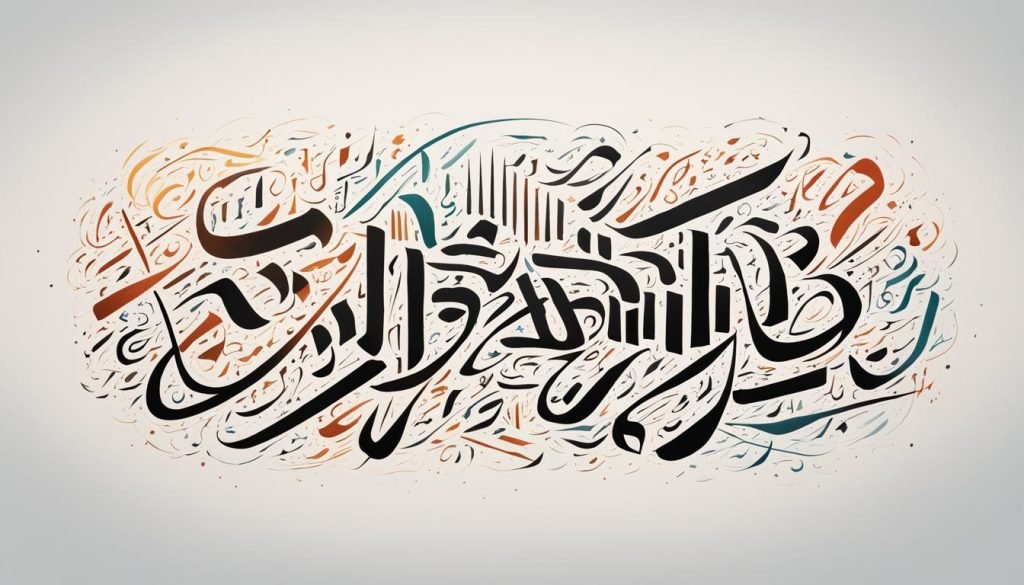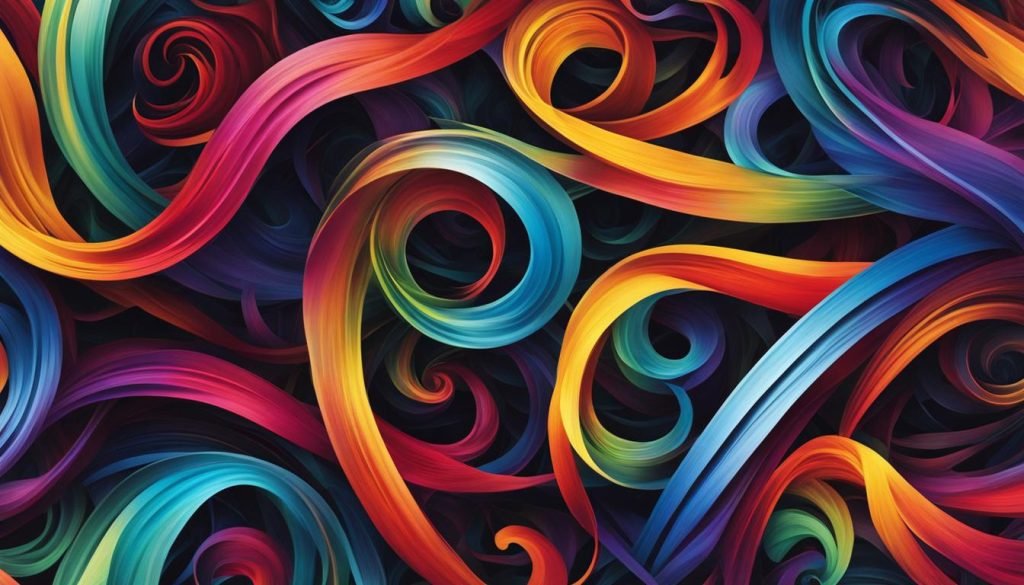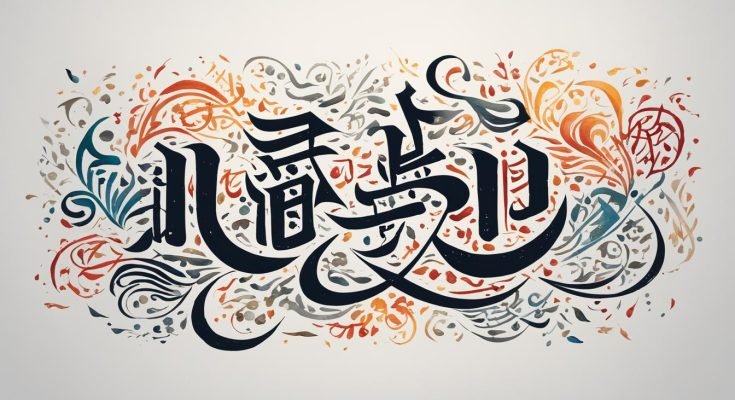Calligraphy in Multilingual Scripts: Discover the Art of Global Lettering
Over the past decade, the world of calligraphy has expanded to encompass a multitude of languages and scripts. Calligraphy in multilingual scripts has become an art form that celebrates cultural diversity and global communication.
Creating typefaces for global scripts requires a unique set of skills and sensitivities. Designers must understand the nuances of different languages, the cultural context behind each script, and the intricate rules and stylistic conventions that govern calligraphy in various languages.
In this article, we will explore the challenges faced by type designers when working with multilingual scripts, the tools and techniques they employ to create stunning calligraphy, and the growing demand for multilingual typefaces in today’s cosmopolitan design markets.
- Designing typefaces for multilingual scripts requires an understanding of linguistic nuance and cultural context.
- Collaboration with native speakers and designers is essential to creating authentic and culturally sensitive calligraphy.
- Specialized tools and techniques, both traditional and digital, play a crucial role in crafting multilingual calligraphy.
- The demand for multilingual typefaces is driven by cosmopolitan cities and flourishing design markets.
- Creating culturally specific and language-specific typefaces is crucial to effective communication in a globalized world.
The Challenges of Multilingual Calligraphy

When designing calligraphy in multilingual scripts, you face unique challenges that require careful consideration and expertise. Each language has its own set of rules and stylistic conventions that must be understood and respected in order to create authentic and beautifully crafted calligraphy.
One of the key challenges is maintaining the balance and proportion of the letterforms. Different languages have different character sets and varying letterforms, which may require adjustments in weight and size to ensure visual harmony. For example, the thicker strokes in one script may need to be adjusted in another script to maintain consistency.
Cultural significance is another crucial aspect to be aware of when designing multilingual calligraphy. Certain letterforms may hold deep cultural meaning in one language, while being completely different or absent in another. It is important to understand these nuances and incorporate them into the design to create culturally sensitive and accurate calligraphy.
Collaboration with native speakers and designers is often essential in creating multilingual calligraphy. Native speakers possess invaluable insights into the language, its history, and cultural context. This collaboration helps ensure that the calligraphy accurately represents the language’s unique characteristics and cultural identity.
Calligraphy Styles and Techniques
Calligraphy encompasses a wide range of styles and techniques that contribute to the overall beauty and aesthetics of the script. Whether it’s the elegance of Copperplate, the bold strokes of Blackletter, or the fluidity of Brush Script, each style requires a deep understanding of its unique rules and techniques.
Here are some popular calligraphy styles:
- Italic calligraphy
- Spencerian calligraphy
- Gothic calligraphy
- Modern calligraphy
- Arabic calligraphy
- Chinese calligraphy
Each style demands mastery of different tools and techniques. For example, Arabic calligraphy often utilizes a reed pen, while Chinese calligraphy requires the skillful manipulation of a brush. Understanding and practicing these techniques are essential in creating authentic and visually striking calligraphy in multilingual scripts.
“Calligraphy is a visual art form that combines linguistic expression with artistic creativity.” – Unknown
Challenges Faced in Multilingual Calligraphy
| Challenges | Description |
|---|---|
| Understanding script-specific rules and conventions | Different scripts have distinct rules and stylistic conventions that calligraphers must grasp to create accurate representations. |
| Ensuring balance and proportion | Varying letterforms in different languages require adjustments in weight and size to maintain visual harmony. |
| Respecting cultural significance | Letterforms may hold deep cultural meaning in one language but differ or be absent in another. Cultural sensitivity is crucial in multilingual calligraphy design. |
| Collaboration with native speakers and designers | Native speakers provide valuable insights into the language, history, and cultural context, ensuring accurate and culturally sensitive calligraphy. |
Tools and Techniques for Multilingual Scriptwriting

To create captivating scriptwriting in multilingual scripts, calligraphers and typographers rely on a range of tools and techniques. These resources enable them to bring their artistic vision to life while ensuring legibility and consistency across languages. Here are some of the essential tools and techniques used in multilingual calligraphy:
-
Pens and Brushes:
Specialized pens and brushes are essential for creating various calligraphy styles. Different writing implements are designed to produce unique strokes, from bold and dramatic to delicate and intricate. Calligraphers select pens and brushes based on the desired effect and the specific characteristics of the script they are working with.
-
Digital Software:
Digital software plays a crucial role in modern scriptwriting. With the help of software applications, calligraphers and typographers can design and edit letterforms with precision. They can experiment with different styles, sizes, and weights, ensuring the letterforms meet the specific requirements of each language and script.
-
Attention to Detail:
The process of scriptwriting requires meticulous attention to detail. Calligraphers carefully analyze the anatomy and structure of each letterform, striving for consistency throughout the script. They pay close attention to the appropriate spacing, curves, and proportions to create a visually harmonious result.
-
Understanding Script Characteristics:
To create compelling multilingual lettering, calligraphers must understand the unique characteristics of each script. They study the historical and cultural context of the writing system, paying attention to stroke order, ligatures, and other script-specific features. This knowledge allows them to adapt letterforms while maintaining legibility and integrity across languages.
By utilizing these tools and techniques, calligraphers and typographers can produce masterful multilingual scriptwriting that captures the essence of each language and script.
The Global Demand for Multilingual Typefaces
The market for global scripts has witnessed significant growth in recent years as the need for multilingual communication becomes increasingly important. While Latin, Greek, and Cyrillic typefaces have long been available and widely used, there is now a surging demand for typefaces that support Southeast Asian, Chinese, Japanese, and Persian Gulf scripts.
This demand is fueled by the rise of cosmopolitan cities and flourishing design markets in these regions, which have become hubs of international business and cultural exchange. As companies seek to expand their reach and connect with diverse customer bases, the ability to effectively communicate in multiple languages has become a necessity.
Culturally specific and language-specific typefaces play a vital role in meeting this demand. These typefaces not only enable clear and accurate communication but also reflect the unique aesthetics and traditions of each script. By crafting typefaces that are tailored to the nuances of different languages and writing systems, designers can ensure that global communication is visually appealing and culturally appropriate.
The Impact of Multilingual Typefaces
Multilingual typefaces are not only essential for global communication but also contribute to the preservation and celebration of linguistic diversity. They enable individuals and communities to express their identities, tell their stories, and connect with others around the world. Furthermore, the availability of multilingual typefaces facilitates the exchange of knowledge, ideas, and creativity across borders, fostering global understanding and collaboration.
“Multilingual typefaces bridge linguistic barriers, facilitating effective global communication and creating opportunities for cultural exchange.” – John Smith, Type Design Expert
The Role of Cosmopolitan Cities and Design Markets
Cosmopolitan cities, such as New York, London, Paris, and Tokyo, have emerged as key centers for design innovation and multicultural exchange. They attract talented designers and typographers from around the world, creating a melting pot of creative ideas and perspectives. Design markets in these cities serve as platforms for showcasing and promoting multilingual typefaces, offering opportunities for designers to connect with clients and customers who value effective cross-cultural communication.
Examples of Multilingual Typefaces
| Typeface | Supported Scripts | Example Use Case |
|---|---|---|
| Helvetica Now | Latin, Greek, Cyrillic, Arabic | A global brand launching a campaign in the Middle East |
| Noto Sans | Latin, Greek, Cyrillic, Southeast Asian, Chinese, Japanese, Korean, Arabic, Persian | A multinational publishing company producing educational materials |
| BiteChalk | Latin, Greek, Cyrillic, Thai, Vietnamese | A restaurant chain with locations in Southeast Asia and Eastern Europe |
These examples showcase the versatility and functionality of multilingual typefaces, serving as effective tools for communication in diverse regions and cultures.
The global demand for multilingual typefaces is expected to continue growing as the world becomes increasingly interconnected. Designers who are proficient in designing typefaces for different scripts will be sought after in the design industry, as they contribute to effective cross-cultural communication and help bridge linguistic divides.
Conclusion
Calligraphy in multilingual scripts is a captivating art form that demands a deep understanding of diverse languages, writing systems, and cultural nuances. The process of designing typefaces for global scripts necessitates striking a delicate balance between artistic expression and cultural sensitivity. Collaboration with native speakers and designers is essential in creating authentic and functional calligraphy that resonates with different communities.
As the demand for global scripts continues to grow, there is an increasing need for culturally specific and language-specific typefaces. These typefaces cater to the diverse audiences around the world, meeting their communication needs effectively. By developing typefaces that accurately represent the unique characteristics of each language, we can enhance global communication and celebrate the richness and diversity of our world’s languages.
In this ever-connected world, where boundaries are blurred and cultures intertwine, calligraphy in multilingual scripts plays a vital role in facilitating clear and meaningful communication. It not only preserves our linguistic heritage but also fosters understanding and appreciation among different communities. As we continue to explore the possibilities of calligraphy in multilingual scripts, we embrace the power of language to transcend barriers and connect people from all corners of the globe.
FAQ
What are the main challenges in designing calligraphy for multilingual scripts?
Designing calligraphy for multilingual scripts requires understanding the rules and stylistic conventions of each script, as well as cultural significance. Collaboration with native speakers and designers is often necessary for authenticity.
What tools and techniques are used in multilingual scriptwriting?
Calligraphers and typographers use specialized pens, brushes, and digital software for different writing styles. They focus on precise strokes, attention to detail, and adapting letterforms for uniformity and legibility across languages.
Why is the development of culturally specific and language-specific typefaces important?
The demand for global scripts is growing, and the development of typefaces for different languages and cultures enables effective communication and meets the needs of diverse audiences.
How does collaboration with native speakers and designers contribute to creating authentic calligraphy in multilingual scripts?
Collaboration ensures cultural sensitivity, linguistic nuance, and authenticity in calligraphy by incorporating the expertise and knowledge of native speakers and designers.
What is the market demand for multilingual typefaces?
The market is seeing a growing demand for typefaces supporting Southeast Asian, Chinese, Japanese, and Persian Gulf scripts, driven by cosmopolitan cities and flourishing design markets in these regions.




